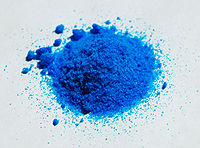Copper nitrate
 |
|
 |
|
| Names | |
|---|---|
|
IUPAC name
Copper(II) nitrate
|
|
| Other names
Cupric nitrate
|
|
| Identifiers | |
|
3251-23-8 10031-43-3 (trihydrate) 13478-38-1 (hexahydrate) 19004-19-4 (hemipentahydrate) |
|
| 3D model (Jmol) | Interactive image |
| ChEBI |
CHEBI:78036 |
| ChemSpider |
17582 |
| ECHA InfoCard | 100.019.853 |
| PubChem | 18616 |
| RTECS number | GL7875000 |
| UNII |
9TC879S2ZV |
|
|
|
|
| Properties | |
| Cu(NO3)2 | |
| Molar mass | 187.5558 g/mol (anhydrous) 241.60 g/mol (trihydrate) 232.591 g/mol (hemipentahydrate) |
| Appearance | blue crystals hygroscopic |
| Density | 3.05 g/cm3 (anhydrous) 2.32 g/cm3 (trihydrate) 2.07 g/cm3 (hexahydrate) |
| Melting point | 256 °C (493 °F; 529 K) (anhydrous, decomposes) 114.5 °C (trihydrate) 26.4 °C (hexahydrate, decomposes) |
| Boiling point | 170 °C (338 °F; 443 K) (trihydrate, decomposes) |
|
trihydrate: 381 g/100 mL (40 °C) 666 g/100 mL (80 °C) hexahydrate: 243.7 g/100 mL (80 °C) |
|
| Solubility | hydrates very soluble in ethanol, ammonia, water; insoluble in ethyl acetate |
| +1570.0·10−6 cm3/mol (~3H2O) | |
| Structure | |
| orthorhombic (anhydrous) rhombohedral (hydrates) |
|
| Hazards | |
| Main hazards | Irritant, Oxidizer |
| Safety data sheet | Cu(NO3)2·3H2O |
| NFPA 704 | |
| US health exposure limits (NIOSH): | |
|
PEL (Permissible)
|
TWA 1 mg/m3 (as Cu) |
|
REL (Recommended)
|
TWA 1 mg/m3 (as Cu) |
|
IDLH (Immediate danger)
|
TWA 100 mg/m3 (as Cu) |
| Related compounds | |
|
Other anions
|
Copper(II) sulfate Copper(II) chloride |
|
Other cations
|
Nickel(II) nitrate Zinc nitrate |
|
Except where otherwise noted, data are given for materials in their standard state (at 25 °C [77 °F], 100 kPa).
|
|
|
|
|
| Infobox references | |
Copper(II) nitrate, Cu(NO3)2, is an inorganic compound that forms a blue crystalline solid. Anhydrous copper nitrate forms deep blue-green crystals and sublimes in a vacuum at 150-200 °C. Copper nitrate also occurs as five different hydrates, the most common ones being the trihydrate and hexahydrate. These materials are more commonly encountered in commerce than in the laboratory.
Hydrated copper nitrate can be prepared by hydration of the anhydrous material or by treating copper metal with an aqueous solution of silver nitrate or concentrated nitric acid:
Anhydrous Cu(NO3)2 forms when copper metal is treated with N2O4:
Attempted dehydration of any of the hydrated copper(II) nitrates by heating instead affords the oxides, not Cu(NO3)2. At 80 °C, the hydrates convert to "basic copper nitrate" (Cu2(NO3)(OH)3), which converts to CuO at 180 °C. Exploiting this reactivity, copper nitrate can be used to generate nitric acid by heating it until decomposition and passing the fumes directly into water. This method is similar to the last step in the Ostwald process. The equations are as follows:
Natural basic copper nitrates include the rare minerals gerhardtite and rouaite, both being polymorphs of Cu2(NO3)(OH)3 substance.
Anhydrous copper(II) nitrate has been crystallized in two solvate-free polymorphs. α- and β-Cu(NO3)2 are fully 3D coordination polymer networks. The alpha form has only one Cu environment, with [4+1] coordination, but the beta form has two different copper centers, one with [4+1] and one that is square planar. The nitromethane solvate also features "[4+ 1] coordination", with four short Cu-O bonds of approximately 200 pm and one longer bond at 240 pm. They are coordination polymers, with infinite chains of copper(II) centers and nitrate groups. In the gas phase, copper(II) nitrate features two bidentate nitrate ligands (see image at upper right). Thus, evaporation of the solid entails "cracking" to give the copper(II) nitrate molecule.
...
Wikipedia

